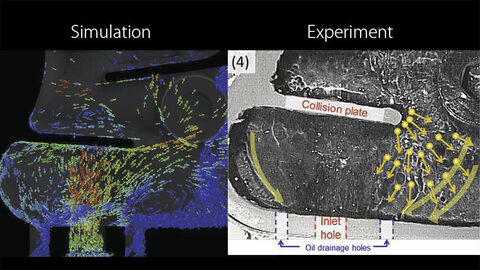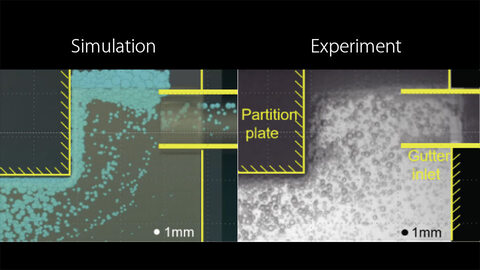Particleworks for Motorsports – Mechanical Vehicle Subsystems

Particle-Based Meshless CFD Simulations for Motorsports
CFD (Computational Fluid Dynamic) software is an integral part of Motorsports success. The cost savings, time savings, safety improvement, and efficiency can be a game changer when measuring success by milliseconds. Simulation tools and consulting can help reduce spending and improve performance and reliability on race day.
From large-scale projects for performance racing teams; to engagements with small teams EnginSoft USA engineers and Particleworks can deliver accurate data, and repeatable results bringing performance data that may have only been previously available or was otherwise too cost-prohibitive to physically test and iterate. This can help in areas such as:
- Oil Distribution
- Inner Cooling
- Gear Cases
- Weight Transfer
- Windage/Crankcase Evacuation
- Parasitic Power Loss Analysis with Co-Simulation
This repeatable, malleable data allows you to not only understand your car in an unprecedented way, but gives you the flexibility to then take what you have and optimize it. The ability to do numerous simulations and identify the optimal solution before deploying valuable resources to implement the can move you to the front of the grid or up the grid substantially.
Oil distribution calculation in transmissionCourtesy of UNIVANCE CORPORATION Simulating the behavior of oil that is stirred by the rotation of multiple gears and dispersed in the transmission. In addition to measuring the amount of oil at the evaluation area, the torque on the shaft caused by the fluid force can also be evaluated. Download the full paper | ||
 |
Simulation of Oil Separating Behavior for Engine Breather SystemCourtesy of Honda R&D Simulating the behavior of oil mist separation from the airflow in the breather chamber. Download the full paper | |
 |
Studies on Particle Method Simulation of Bubble Behavior in Engine Lubricating Oil (First Report)Courtesy of Honda R&D Simulating the behavior of air bubbles inside an engine lubricant flow. A correlation between simplified experiments and simulations of the bubbles' movement and dissipation has been verified and a good correlation has been obtained. | |
Bubble generation analysis by gear oil stirringSimulating the behavior of air bubbles which are generated by the rotation of gears and moved with the oil flow. | ||
Simulation of water ingress into the vehicle running on flooded roadParticleworks x Recurdyn couplingBy coupling with RecurDyn, the motion of the vehicle's suspension while driving on a flooded road can be also taken into account, which makes the evaluation more realistic. *This model has been developed by The National Crash Analysis Center (NCAC) of The George Washington University under a contract with the FHWA and NHTSA of the US DOT | ||
Simulation of water splashingParticleworks x Recurdyn couplingSimulating the behavior of liquid that is splashed up as the vehicle runs over puddles. It allows to evaluate the impact point to the under the car body. *This model has been developed by The National Crash Analysis Center (NCAC) of The George Washington University under a contract with the FHWA and NHTSA of the US DOT | ||
Piston oil jet analysisAbove:Post-processing of vector view of the oil flowBelow:CG rendering based on the simulation result Simulating the oil jet for cooling the piston head. The oil jet impact point and the heat transfer coefficient are used to evaluate the cooling performance of the piston head. | ||
Powertrain Oil Sloshing SimulationAbove:The liquid is shown as particles view and the flow velocity is shown as contour viewBelow:CG rendering based on the simulation result In this simulation, we can see how the engine oil behaves with three gears of different sizes and speeds, ranging from a differential gear with a diameter of about 20 cm and a speed of about 300 rpm to a drive gear with a speed of about 1000 rpm. It is worth noting that you can see how the oil is scraped up by the gears and flows into from the top of the mechanism. At the same time, you can see that the oil does not flow easily depending on the amount of oil and the location of the parts that block the flow path. 【Analysis conditions】 Region:50cm x 30cm x 40cm
| ||
Fuel tank sloshingSimulating the fuel behavior in the fuel tank by applying an external force acceleration which is assuming vehicle driving. | ||
Fuel spill analysis during refueling
| ||
Simulation of oil behavior in a planetary gear systemSimulating the oil behavior in a planetary gear system with complex rotational motion. The oil is stirred up by the rotation of the planetary gears and can be seen spreading throughout the gear equipment. It would be possible to evaluate whether a sufficient amount of oil is lubricating the area of interest. | ||
Simulation of oil lubrication in a ball bearingSimulating the behavior of oil into a rotating ball bearing. It would be possible to evaluate whether the inside of the bearing is sufficiently lubricated with oil. | ||
See the Webinar - How Meritor Uses Particleworks | ||
